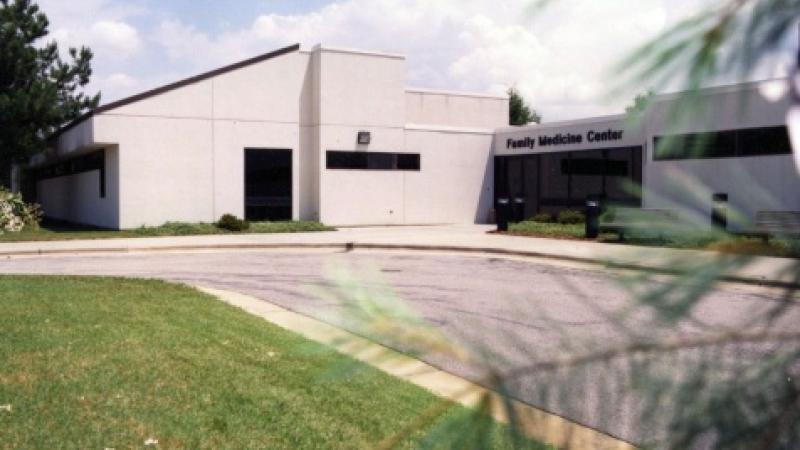
Part 2: Family Medicine at Duke - The Fight for Beds at Duke University Hospital
Editor's Note: This is the second in a seven-part series about the history of family medicine at Duke University Medical Center.
Read Part 1 | Read Part 3 | Read Part 4 | Read Part 5 | Read Part 6 | Read Part 7
Though technically a part of Duke, the family medicine clinical practice of the Department of Community and Family Medicine (originally Community Health Sciences) still faced barriers on campus in the 1970s and 1980s. Family medicine was not assigned beds at Duke University Hospital and physicians could not admit their patients there without first sending them to a specialist. Faculty also were not members of Duke’s physician practice, the Private Diagnostic Clinic (PDC).
“Family medicine did not … develop a presence at Duke Hospital,” said E. Harvey Estes, Jr., M.D., original chair of the Department of Community Health Sciences. “That would have meant that their patients with medical problems would have been admitted to the Department of Medicine, patients for delivery of babies to the OB department, kids to the pediatrics department … They would have been cared for by the house staff of those departments.”
Therefore, family medicine residents and faculty admitted and referred their patients to Durham County General Hospital, where the Duke-Watts Family Medicine Center was located, instead of to Duke.
“We hospitalized patients, they were at Durham Regional [Durham County General],” said Kathryn M. Andolsek, M.D., MPH, then-director of the family medicine residency program. “We delivered babies at Durham Regional. We needed lab, x-ray, physical therapy, we used Durham Regional. If we needed consultants, we used the community guys who were at Durham Regional. So we only rarely referred over to Duke Hospital.”
In a recent interview, Joseph Greenfield, Jr., M.D., James B. Duke Professor of Medicine, and former chair of the Department of Medicine, said that the subspecialty departments, such as medicine and surgery, fought daily for beds in Duke University Hospital.
“It was a knock-down drag-out fight every day as to whether you were going to get your patient admitted or not,” Greenfield recalled. “The fight always has been who owns the beds. … Who had the beds is who controlled things.”
Greenfield said that the family medicine faculty were prevented from having admitting privileges at the hospital by David Sabiston, Jr., M.D., then-chair of the Department of Surgery. Sabiston died in 2009.
“He had no use for them at all,” Greenfield said. “He didn’t want them in Duke Hospital.”
‘Full partner instead of a stepchild’
In 1979, the name of the department changed to the Department of Community and Family Medicine, and family medicine became a required School of Medicine clinical rotation. In 1981, the rotation was expanded to a full eight-week clinical clerkship; however, the struggle between the department and the medical center continued.
On April 26, 1982, William Anlyan, M.D., then-chancellor of health affairs for Duke University, sent a memo to a group of physicians and administrators asking for a strategic planning group to consider ways to enhance the participation of the Department of Community and Family Medicine in Duke University Medical Center. The memo was sent to several department chairs, including Estes and Sabiston, and other leaders in the medical center.
“I would appreciate developing a plan to see that the patient-care activities of the department are centripetal and not centrifugal,” Anlyan wrote. “I’m concerned about the referral to external groups of patients for specialty care. There are obviously two sides to the historic development of the current situation.”
During an interview in August 2015, a few months before his death at the age of 90, Anlyan said there were two issues at play during this time: family medicine physicians were referring specialty cases to the county hospital instead of to Duke, and family medicine physicians felt like they were regarded as second-class citizens at Duke.
“The overlying, I think, malaise … by the people in family medicine was that they were regarded as second-class citizens,” Anlyan said. “Whereas the specialists at Duke felt that I … gave them [family medicine physicians] more than they deserved.” Anlyan said that Sabiston, in particular, felt the Department of Community and Family Medicine was given special treatment.
“Although, if you asked me,” Anlyan said, “resources being money and space, I don’t remember doing anything special.”
Memos available at Duke University Medical Center Archives document an ongoing struggle between the Department of Community and Family Medicine and other clinical departments in the medical center.
In a memo written by Estes to Anlyan on March 4, 1983, Estes asked for help in “making this department a full partner at Duke Hospital instead of a stepchild.” Estes described criticism the department had received regarding hospitalizing certain patients — specifically Duke students and faculty — at Durham County General Hospital.
“The problem is, of course, that we cannot admit at Duke,” Estes wrote. “At the same time we are asked to help the Hospital by sending referrals, etc.”
In another memo written Oct. 11, 1983, Estes defended the Duke-Watts family medicine residents.
“I think that there is absolutely no basis for any allegation that our house staff is inferior in any way to any other house staff at Duke,” Estes wrote. The memo included a list of the previous six classes of residents, their college and medical school records, awards, honors, additional degrees received and brief bios of each resident.
Estes recently recalled that criticism of the family medicine residents was a constant from medicine, surgery, OB-GYN and pediatrics.
Greenfield, who now works half-time at the Duke VA Medical Center reading electrocardiograms, recently commented on the mindset of surgeons regarding family physicians, saying that most surgeons didn’t think family physicians had any business doing minor surgery or delivering babies.
“They [family physicians] do a variety of things which, in a subspecialty environment, … a lot of people feel they’re not qualified to do,” Greenfield said. “And it’s going to be a problem.”
Heavy opposition
Estes, distinguished service professor emeritus of community and family medicine, believed that Anlyan was trying to work out a compromise between the Department of Community and Family Medicine and the other clinical departments of the medical school. But, according to Estes, surgery and medicine were adamantly against family medicine and wanted it gone.
Greenfield agreed in a recent interview that there was opposition, especially by Sabiston.
“From the inception of the department there was always a mixed feeling that Duke, being a subspecialty-driven institution, shouldn’t have a department of family medicine,” Greenfield said. “And that concept carried on and on and on.”
“It’s very clear that if he had his druthers, Sabiston would have had it [family medicine] gone,” Greenfield recalled. “He just … didn’t really believe that Duke medical center, a subspecialty place like this, should have family medicine.”
Estes recently described a supposed incident in the early 1980s that he said led Sabiston to insist to Anlyan that the family medicine training program and clinical practice be eliminated altogether.
Estes said that a Duke University Hospital urology patient was a primary care patient at the Duke-Watts Family Medicine Center, and while in for a primary care visit, was recommended for a urology check at Durham County General Hospital. The patient agreed to the check.
Estes said that when the patient’s Duke urologist later learned of this, he was angry that his patient had been seen by another urologist, especially one at Durham County General Hospital. Estes said the Duke urologist spoke with the chair of surgery, Sabiston, and insisted that Duke-Watts family medicine needed to go.
Estes said that Sabiston promptly spoke to Anlyan to convince him that family medicine needed to be removed from Duke, and Estes said that Sabiston recruited Greenfield to join him in his push to remove family medicine.
“They together introduced this at a meeting of the department chairs,” Estes recalled. “And there was a difference of opinion. Pediatrics was kind of neutral. Opthalmology, pathology didn’t give a damn. But medicine and surgery, the two biggest departments in the medical center, were adamant that this clinic and this service over at the new Durham General Hospital had to be obliterated off the face of the earth.”
“And Bill Anlyan was in a bind,” Estes said. “Two of his biggest departments were insisting on it so he said, … as he did in every case of that sort, ‘Let’s form a committee. Let’s study this issue.’ “
In a recent interview, Greenfield insisted he never wanted family medicine gone and was always supportive of it.
“To be very frank with you, if I had joined Sabiston there wouldn’t be any family medicine here,” Greenfield said. “That’s all it boils down to. It’d be gone.”
